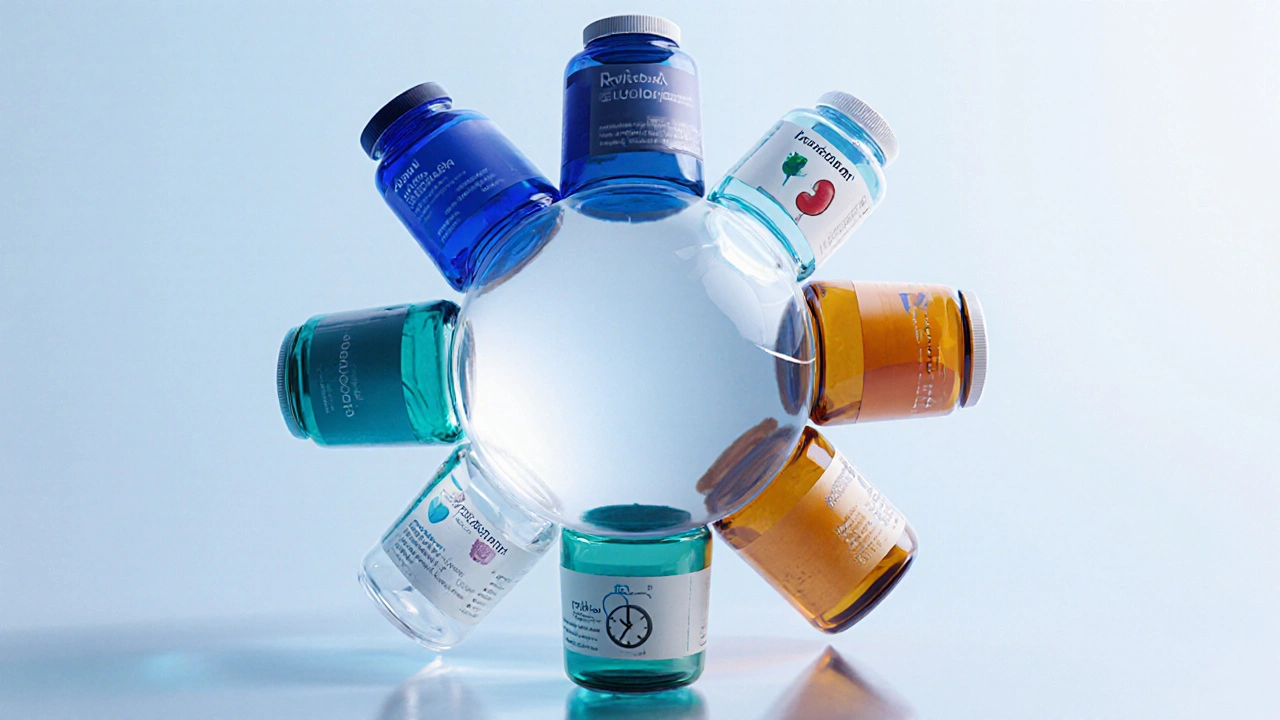Warfarin vs Alternatives: Medication Selector
Recommended Options
Medication Comparison Overview
Warfarin (Medex): Effective but requires frequent INR monitoring, dietary restrictions, and careful management of drug interactions. DOACs: Newer alternatives with fixed dosing, fewer interactions, and no routine lab work needed.
| Medication | Mechanism | Dosing | Monitoring | Cost (Monthly) |
|---|---|---|---|---|
| Warfarin | Vitamin K Antagonist | Once daily | INR every 4–6 weeks | $5–$160 |
| Apixaban | Factor Xa Inhibitor | Twice daily | None | $300–$500 |
| Rivaroxaban | Factor Xa Inhibitor | Once daily | None | $350–$600 |
| Dabigatran | Thrombin Inhibitor | Twice daily | None | $400–$700 |
| Edoxaban | Factor Xa Inhibitor | Once daily | None | $300–$500 |
Every year, millions of patients worldwide rely on a blood‑thinning medication to keep dangerous clots at bay. Medex is a branded version of warfarin, a vitamin K antagonist that has been the go‑to anticoagulant since the 1950s. While it works, the drug demands regular blood tests, strict diet rules, and constant attention to drug interactions. What if you could avoid all that hassle? Below we break down the most common Warfarin alternatives, compare them head‑to‑head, and help you decide which option fits your lifestyle and health profile.
Key Takeaways
- Medex (warfarin) requires INR monitoring and has many food/drug interactions.
- Direct oral anticoagulants (DOACs) such as apixaban, rivaroxaban, dabigatran, and edoxaban offer fixed dosing and no routine lab work.
- Renal function, cost, and bleeding risk are the main decision factors when switching from warfarin.
- Heparin remains useful for short‑term, hospital‑based anticoagulation, while aspirin is not a true substitute for high‑risk clot prevention.
How Warfarin Works - The Medex Story
Warfarin (the active ingredient in Medex) blocks the recycling of vitamin K, which is essential for clotting factor production in the liver. By reducing those factors, blood takes longer to clot. The downside? The effect varies with diet, genetics, and other medications, so clinicians monitor the International Normalized Ratio (INR) to keep it in the therapeutic window (usually 2.0-3.0 for most indications).
Why Patients Look for Alternatives
Four pain points drive the search for something else:
- Frequent INR checks: Monthly clinic visits or home testing kits add time and expense.
- Food restrictions: Leafy greens, broccoli, and vitamin K‑rich foods can swing INR dramatically.
- Drug interactions: Antibiotics, antifungals, and even over‑the‑counter supplements can destabilize warfarin levels.
- Bleeding risk: Over‑anticoagulation leads to serious bleeds, especially in older adults.
Enter the newer class of direct oral anticoagulants (DOACs), which bypass many of these hurdles.

Meet the Main Alternatives
Below are the top contenders that clinicians prescribe as warfarin replacements.
- Apixaban (brand name Eliquis) is a factor Xa inhibitor with a half‑life of about 12 hours.
- Rivaroxaban (Xarelto) also blocks factor Xa but is taken once daily for most indications.
- Dabigatran (Pradaxa) is a direct thrombin inhibitor, requiring twice‑daily dosing.
- Edoxaban (Savaysa) is another factor Xa inhibitor, approved for non‑valvular atrial fibrillation and VTE treatment.
- Heparin (unfractionated) is a parenteral anticoagulant used mainly in hospitals; it works by enhancing antithrombin activity.
- Aspirin is an antiplatelet drug, not a full anticoagulant, but sometimes mentioned as a low‑risk alternative for certain patients.
Side‑by‑Side Comparison Table
| Anticoagulant | Brand(s) | Mechanism | Dosing Frequency | Monitoring Required | Food/Drug Interactions | Renal Adjustment | Typical US Cost / month (USD) |
|---|---|---|---|---|---|---|---|
| Warfarin | Medex, Coumadin | VitaminK antagonist | Once daily | INR 2‑3 (weekly‑monthly) | High (leafy greens, many meds) | None required | $5‑15 (generic) / $120‑160 (brand) |
| Apixaban | Eliquis | FactorXa inhibitor | Twice daily | No routine labs | Low | Yes - dose cut‑back if CrCl <30ml/min | $350‑$400 |
| Rivaroxaban | Xarelto | FactorXa inhibitor | Once daily (or BID for VTE) | No routine labs | Low | Yes - avoid if CrCl <15ml/min | $320‑$380 |
| Dabigatran | Pradaxa | Direct thrombin inhibitor | Twice daily | No routine labs | Low | Yes - reduce if CrCl 30‑50ml/min | $340‑$410 |
| Edoxaban | Savaysa | FactorXa inhibitor | Once daily | No routine labs | Low | Yes - dose cut‑back if CrCl 15‑50ml/min | $300‑$350 |
| Heparin | Various | Antithrombin activator | IV or SC continuous | Activated PTT | Moderate | None | $50‑$150 (hospital stay) |
Decision Criteria - What Matters Most?
When you or your clinician weigh switching from Medex, keep these five factors front‑and‑center.
- Renal function: DOACs are partially cleared by the kidneys. If your creatinine clearance is below 30ml/min, warfarin often stays safest.
- Bleeding profile: Apixaban consistently shows the lowest major‑bleed rates in head‑to‑head trials, making it a top pick for older adults.
- Cost & insurance coverage: Generic warfarin is cheap, but the hidden cost of INR testing and dietary counseling can add up. Many insurers now cover DOACs with modest co‑pays.
- Adherence ease: Fixed dosing without lab visits boosts compliance. For patients who miss appointments, a DOAC can be a game‑changer.
- Specific indication: Mechanical heart valves and severe mitral stenosis still require warfarin; DOACs are not approved for those conditions.

Pros and Cons of Each Option
Here’s a quick snapshot of the strengths and weaknesses you’ll encounter.
| Drug | Pros | Cons |
|---|---|---|
| Warfarin (Medex) | Very cheap; reversible with vitaminK; long track record; suitable for valve disease | Frequent INR checks; many food/drug interactions; variable dosing |
| Apixaban | Lowest bleed risk; no routine labs; twice‑daily dosing fits most schedules | Costlier; requires renal dosing adjustment |
| Rivaroxaban | Once‑daily convenience; approved for atrial fibrillation and VTE prophylaxis | Higher GI bleed risk than apixaban; not advised for severe renal impairment |
| Dabigatran | Strong anti‑thrombin effect; approved for stroke prevention after atrial fibrillation | Must be taken with food for absorption; higher dyspepsia reports |
| Edoxaban | Once‑daily dosing; lower intracranial bleed rates | Limited real‑world data compared to other DOACs |
| Heparin | Rapid onset; reversible with protamine; ideal for hospital use | IV/SC administration; requires lab monitoring (aPTT) |
| Aspirin | Cheap; over‑the‑counter | Not sufficient for high‑risk clot prevention; higher GI bleed risk at therapeutic doses |
Real‑World Scenarios - Which Choice Fits?
Scenario 1 - A 68‑year‑old with atrial fibrillation, normal kidney function, and a busy travel schedule. The need for weekly INR checks makes warfarin a hassle. Apixaban’s low bleed risk and twice‑daily dosing align well with an active lifestyle.
Scenario 2 - A 75‑year‑old with chronic kidney disease (CrCl 28ml/min). DOACs would need dose reduction, and safety data are limited below 30ml/min. Warfarin remains the safer bet despite monitoring.
Scenario 3 - A 55‑year‑old undergoing knee replacement surgery. Short‑term anticoagulation is required. Heparin (or LMWH) in the hospital, followed by a brief course of rivaroxaban once daily for six weeks, offers convenience and proven efficacy.
How to Switch Safely
- Consult your healthcare provider to confirm the indication is suitable for a DOAC.
- Stop warfarin and check the INR; when INR falls below 2.0, start the chosen DOAC at the recommended dose.
- If you have renal impairment, have your latest eGFR or creatinine clearance results ready before the switch.
- Set up a pharmacy reminder for refills; many insurers now offer automatic mail‑order for DOACs.
- Schedule a follow‑up after 1-2 weeks to ensure no unexpected bleeding or clotting signs.
Most patients notice a smoother daily routine within a week of the change.
Frequently Asked Questions
Can I stop taking Medex without a doctor’s approval?
Never. Stopping warfarin abruptly can cause a rebound clotting risk. Always get a medical plan for the exact timing and the replacement drug.
Are DOACs reversible if I have a serious bleed?
Yes. Specific reversal agents exist: idarucizumab for dabigatran, andexanet alfa for factorXa inhibitors (apixaban, rivaroxaban, edoxaban). They are pricier and not always stocked in smaller hospitals, but they provide a safety net.
Do I need to watch my diet on apixaban like I did on warfarin?
No. Apixaban’s effect isn’t altered by vitaminK intake, so you can enjoy leafy greens without blood‑test anxiety.
Is warfarin still the best choice for mechanical heart valves?
Exactly. Current guidelines reserve warfarin for patients with mechanical prostheses or moderate‑to‑severe mitral stenosis because DOAC trials excluded those groups.
How much does a typical DOAC cost compared to generic warfarin?
Generic warfarin averages $10‑$15 per month, while DOACs range from $300‑$400. Insurance coverage can shrink the gap, but out‑of‑pocket spend is still higher for DOACs.







nathaniel stewart
October 10, 2025 AT 00:23Dear fellow readers, I sincerely applaud the thorough breakdown of warfarin versus its modern counterparts, and I encourage you to weigh the convenience of DOACs against the time‑tested reliability of Medex; despite occasional lab visits, the flexibility of dosing may indeed suit many patients, and I wish you the best in your therapeutic choices. Keep an open mind, and may your health journey be smooth and successful.
Pathan Jahidkhan
October 18, 2025 AT 04:13Warfarin is the ancient alchemist's potion, a relic of a bygone era, yet we cling to its legacy as though it were gospel. The modern DOACs whisper promises of freedom, but they also hide shadows. In the grand theater of anticoagulation, one must ask: Are we chasing convenience or surrendering safety?
Michele Radford
October 26, 2025 AT 08:03The grim truth is that many patients remain oblivious to the perilous dance of vitamin K interactions, and it is a moral failing of our healthcare system to allow such ignorance to persist. Those who cling to warfarin without proper monitoring are essentially gambling with their lives, and the responsibility lies squarely on both physician and patient.
Mangal DUTT Sharma
November 3, 2025 AT 11:53I understand how overwhelming the decision can feel, especially when you’re juggling appointments, diet, and the ever‑present fear of bleeding. The good news is that you’re not alone; countless individuals have walked this path and emerged with a regimen that fits their lifestyle. 😊 First, consider the frequency of INR monitoring – if weekly visits are a burden, a DOAC might offer relief. Second, think about your diet; if you love leafy greens, the strict restrictions of warfarin could become a daily source of stress. Third, evaluate your current medication list, because drug interactions with warfarin are notoriously complex. Fourth, reflect on your renal function; many DOACs require dose adjustments, whereas warfarin is more forgiving in severe impairment. Fifth, weigh the financial aspect – while warfarin is cheap, the hidden costs of testing can add up. Sixth, discuss with your cardiologist the specific indication you have, as some studies suggest certain DOACs are superior for atrial fibrillation. Seventh, ask about reversal agents; dabigatran and apixaban now have specific antidotes, which can provide peace of mind. Eighth, consider the bleeding risk profile; some DOACs have shown lower intracranial bleed rates. Ninth, remember that adherence is crucial; a once‑daily pill may be easier to remember than twice‑daily dosing. Tenth, think about future surgeries – warfarin requires a careful bridge, while some DOACs can be stopped briefly. Eleventh, don’t forget the emotional weight of living with a chronic condition; choosing a simpler regimen can improve quality of life. Twelfth, if you have a supportive family, involve them in the decision; their input can be invaluable. Thirteenth, keep a personal log of any side effects, no matter how minor, to share with your provider. Fourteenth, stay updated – guidelines evolve, and what’s best today might shift tomorrow. Finally, trust your instincts; you know your body and lifestyle best, and a shared decision‑making approach will lead to the most satisfying outcome. 🌟
Gracee Taylor
November 11, 2025 AT 15:43It’s great to see a balanced overview that acknowledges both the convenience of DOACs and the cost‑effectiveness of warfarin, allowing patients to make informed choices based on their individual circumstances.
Leslie Woods
November 19, 2025 AT 19:33Interesting point about the trade‑offs. Could we also consider patient education as a factor in adherence
Manish Singh
November 27, 2025 AT 23:23I hear your concerns and truely believe that better education can bridge the gap. It’s essential we support patients with clear guidance, even if occasional lapses happen, and we must keep improving the system.
Dipak Pawar
December 6, 2025 AT 03:13From a pharmacoeconomic perspective, the shift towards direct oral anticoagulants represents a paradigm shift in anticoagulation stewardship, integrating real‑world adherence data with health‑technology assessments to optimize the incremental cost‑effectiveness ratio. Moreover, the pharmacokinetic profiles of factor Xa inhibitors, characterized by predictable bioavailability and minimal hepatic metabolism via CYP3A4, circumvent the need for routine therapeutic drug monitoring, thereby streamlining clinical workflows. In contrast, warfarin’s narrow therapeutic window necessitates frequent INR calibrations, which imposes a logistical burden on both outpatient clinics and patients. The emerging evidence from network meta‑analyses suggests that apixaban may confer a superior safety margin in elderly cohorts, particularly those with comorbid renal insufficiency, due to its dual clearance pathways. Consequently, health systems must weigh the up‑front acquisition costs against downstream savings derived from reduced hospitalization for major bleed events. The decision matrix should incorporate patient‑reported outcome measures, as quality‑adjusted life‑year (QALY) calculations often favor DOACs in populations with high INR variability.